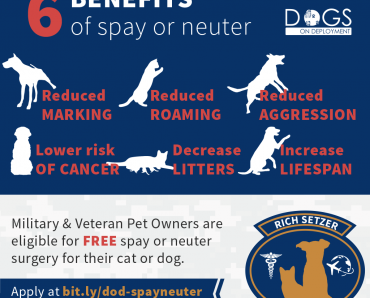Whether it be a blizzard keeping you in the house, a tornado forcing you to seek shelter, a fire displacing your family, or a hurricane demanding that you to evacuate, disasters require preparation. We all have plans for what we need to do to help our families, but do those plans include pets?
If not, they should. It turns out that it’s not too difficult to add your pet to your family’s disaster preparedness plan. It’s as easy as 1-2-3:
- Pre-Disaster Preparation
- A Readiness Kit
- Evacuation Plan
Pre-Disaster Preparation
The day you get your pet can be the day you start preparing for any disaster because the first decision you make is how to ID your pet . ID options include a tag with an address and phone number and/or getting a microchip implanted, or other options. The most important thing is to make sure that your pet’s ID is current.
Another necessary step is making sure your pet is up-to-date on his/her shot records and flee/tick prevention. Most shelters will not allow pets into their facilities, if they are not up-to-date, on their shots. If a flood destroys your home, and you need to board your pet, the last thing you need to worry about is being turned away from a reputable shelter because your dog isn’t up to date on his Bordetella (kennel cough) shot.
A final, important preparedness step is to get a sticker for your home that alerts fire, police, and search & rescue personnel that you have a pet. The ASPCA will send them to you, for free. Once evacuated from the dangerous situation, if it’s safe, and if time allows, you should write, “EVACUATED” across the sticker, so rescue personnel know that the animals are safely recovered.
Readiness Kit
Having a readiness kit is crucial to ensuring that your pet is equipped to survive outside of its normal environment, at least for a short period of time. While each pet will have individual needs to make him/her comfortable, there are a few items that should be on everyone’s list:
- Photo of Your Pet: It’s important to have a current photo of your pet, should you get separated.
- Food/ Treats: have food that suits your pet’s dietary needs, and have enough for about ten days. Remember to update this as their nutritional needs change.
- Water: Again, as with food, have enough for about ten days
- Bowls: Something people tend to forget is bowls for food and water. It’s wonderful to stock food and water, but without a container for your animal to eat from, these items become, essentially, useless.
- Collar/Leash: In an emergency situation, and in unfamiliar surroundings, even the most well-trained dog, or calm kitty gets nervous. Make sure you can control your animal with a strong leash and with a collar.
- Comfort Items: If your pet is partial to a specific blanket, a toy, or even a kennel, keep it with, or near, your emergency supplies. The scent of these items may help calm a nervous animal.
- Medical Supplies- Shot records, medications and grooming supplies should be packed with the emergency kit, not scattered around the house.
Evacuation Plan
If you do not live in an area where you have family near, or your area does not have any pet friendly emergency shelters, then you need a plan for where your pet will go, in an emergency. Having your Readiness Kit stocked ensures that no matter where your pet has to go, they will be comfortable, but finding a place ahead of time, ensures they will be safe.
A good plan includes a network of friends, family, neighbors and boarding facilities, both local and in surrounding communities (in case your local facilities are affected by whatever emergency has you fleeing your home). Having a ready list of places to turn to prevents last minute scrambling, and a potential disaster for your pet.
Most importantly, never leave your pet alone to fend for itself in a disaster situation. Contrary to what some might believe, that the animal’s survival instincts will help it along, these animals often end up requiring rescue, and are often injured, sick and scared. Plan ahead and keep your animal safe and cared for, with you, or with a caretaker.
In general, it is important to prepare you and your family in case of a disaster; your pet is part of your family too. Prepare for their care, the same way you prepare for your own.
Some great resources for preparing your pet include:





